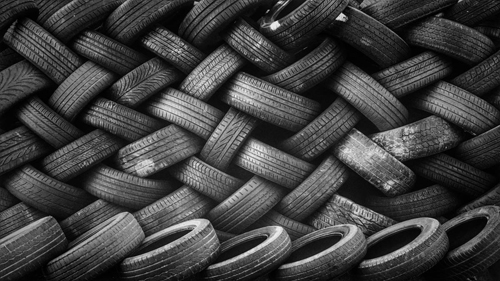How Tires are Made

Tires are the only part of your vehicle that comes in contact with the road and the entire weight (including contents) is supported by a cushion of air inside them. Besides the critical role that tires play in supporting the weight of your vehicle, the internal components and tread design are extremely complex and have a direct impact on your safety.
The most common type of passenger tires are radial tires, which consist of one or two casing, or sidewall, plies that are comprised of either fabric or steel cords and aligned 90 degrees to the beads. Tread plies are then added for directional stability and puncture resistance. Each ply is actually made up of individual cords that are twisted like cables, laid side by side and encased in rubber to form a uniform sheet of fabric or steel and rubber.
The basic manufacturing process for a radial tire starts with a thin layer of air-tight synthetic rubber called an innerliner. The casing ply is then added before two strong hoops of steel wire called bead bundles are put in place to anchor the sidewall ply and eventually hold the tire against the rim.
Next, the casing ply is folded over the beads before the sidewall and bead rubber is added. Then a special drum shapes the tire so an even number of tread plies can be positioned on the casing under the tread.
While designs vary by product and manufacturer, every tire has some percentage of natural rubber. The rubber must be blended with up to 200 different compounds such as carbon black, silica, sulfur and synthetic rubber. The combination of ingredients leads to the different performance characteristics for every tire.
Tread rubber is a compromise of properties. Snow and all-terrain tires that deliver excellent traction cannot be expected to deliver the tread mileage of a touring tire that is engineered to operate on paved surfaces. Likewise, tires with a low rolling resistance compound or tread design cannot be expected to perform in mud or snow and ice like a tire engineered for those applications.
Once all of the rubber has been applied to form an uncured, or “green tire,” it is placed in a mold and inflated with hot water or steam, which causes the tire to press against the mold. As a result, the mold imprints the tread design and information on the sidewall. While in the mold, the tire is heated to cure the rubber and bond the components. This process is known as vulcanization.
After this curing process is complete, the tire is removed from the mold for cooling and then testing. Each tire is thoroughly inspected for flaws such as bubbles or voids in the rubber of the tread, sidewall and interior of the tire. Then the tire is placed on a test wheel, inflated and spun. Once the tire has been inspected and run on the test wheel, it can be moved to a warehouse for distribution and eventual installation on your vehicle.